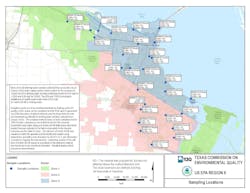The U.S. Environmental Protection Agency (EPA), the Texas Commission on Environmental Quality (TCEQ) and Texas Department of State Health Services (DSHS) have integrated their operations in both Austin, Texas, and Corpus Christi, Texas, to ensure the contaminated drinking water situation is handled as swiftly as possible. The top priority is a transparent response and the safety of Corpus Christi residents, and the organizations will continue to provide any and all support to remedy this situation as quickly as possible. The entire team from the city and state has flushed the system and quickly addressed the situation.
TCEQ and EPA have notified officials with the city of Corpus Christi that all water restrictions can be lifted immediately in Zone 2, which serves about 138,000 people, and Zone 3, which serves about 113,000 people. Zone 1 drinking water restrictions were lifted Thursday, Dec. 15.
TCEQ and EPA received analytical results from 28 drinking water samples collected in Corpus Christi Dec. 15 to 16. Samples were analyzed by an EPA laboratory using a new liquid chromatography/mass spectrograph (LCMS) and gas chromatography/mass spectrograph (GCMS) analytical method to detect Indulin AA-86 in drinking water.
None of the 28 drinking water samples collected from across the city of Corpus Christi water supply system tested positive for the presence of Indulin AA-86 in drinking water at method detection levels of 0.05 mg/L for LCMS and 0.25 mg/L for GCMS. EPA and TCEQ toxicologists established a health-based action level of 2.6 mg/L for Indulin AA-86 in drinking water.
TCEQ and EPA will remain in a status of situational awareness and collect samples from the Corpus Christi drinking water system and conduct confirmation testing at EPA’s laboratory in Houston over the next few days. Both TCEQ and EPA have deployed additional resources to monitor Corpus Christi’s drinking water system.
Seven reports of possibly related symptoms from prohibited water use by people living in Corpus Christi have been unconfirmed. The Texas DSES recommends citizens with health questions contact their local healthcare professionals.
Citizens concerned about their drinking water quality should contact the city of Corpus Christi at 361.826.2489 or TCEQ at 888.777.3186. Citizens with health or exposure questions should contact the Poison Control Center at 800.222.1222.
TCEQ and EPA will make analytical data and sampling locations available on the Corpus Christi website at www.tceq.texas.gov/response/corpus-christi-emergency-response.
The sample sites used for monitoring Zones 2 and 3 were selected in coordination with TCEQ and EPA. Several sample site locations were selected in each zone because they are representative sites for routine and frequent compliance monitoring of water quality in the distribution system in accordance with city’s approved drinking water monitoring plan.
Other sample sites were selected based on engineering hydraulic flow models proven with historical testing and knowledge of hydraulic flow of water through the city’s distribution system. The locations of the samples are terminal points of the water supply system known as “dead-end mains.” These were chosen as sample sites to ensure that areas where older water could still be in the distribution system were represented. These points are where concentrations of contamination could still remain.
The available information on Indulin AA-86 suggests that there is not a concern for long-term persistence of the substance in aquatic systems, nor is there a concern for bioaccumulation up the food chain. Thus, the agencies do not believe there is any risk in consuming seafood from local estuaries that may be receiving water discharged from the flushing of the drinking water system.
The available information on this chemical on the direct toxicity to estuarine aquatic organisms is limited; toxicity tests are only available for freshwater organisms. Flushing of the drinking water system and release into the local estuary suggests the substance will be at low, if not undetectable, concentrations due to the massive amount of dilution.
Analytical results are to be considered preliminary findings until a full quality control review can be completed and the final report is generated by EPA’s laboratory. Analytical methods used for these tests are new and were developed specifically for drinking water samples collected from Corpus Christi.
The analytical methods have not been validated and the EPA Houston laboratory is not certified to test for this chemical. Quantitation was made using pure Indulin AA-86 (fatty amine derivative) product that was collected in the field and provided to the Houston laboratory by the state of Texas. The salt form of Indulin AA-86 was needed to match the operations at the facility and was created using hydrochloric acid with a ratio of product to salt of 1.0:1.1, per information provided by Ingevity, the manufacturer. Laboratory creation of the salt form of Indulin AA-86 results in uncertainty of the reference material and results are to be considered estimates. Standard quality control procedures were followed.
Source: U.S. Environmental Protection Agency


